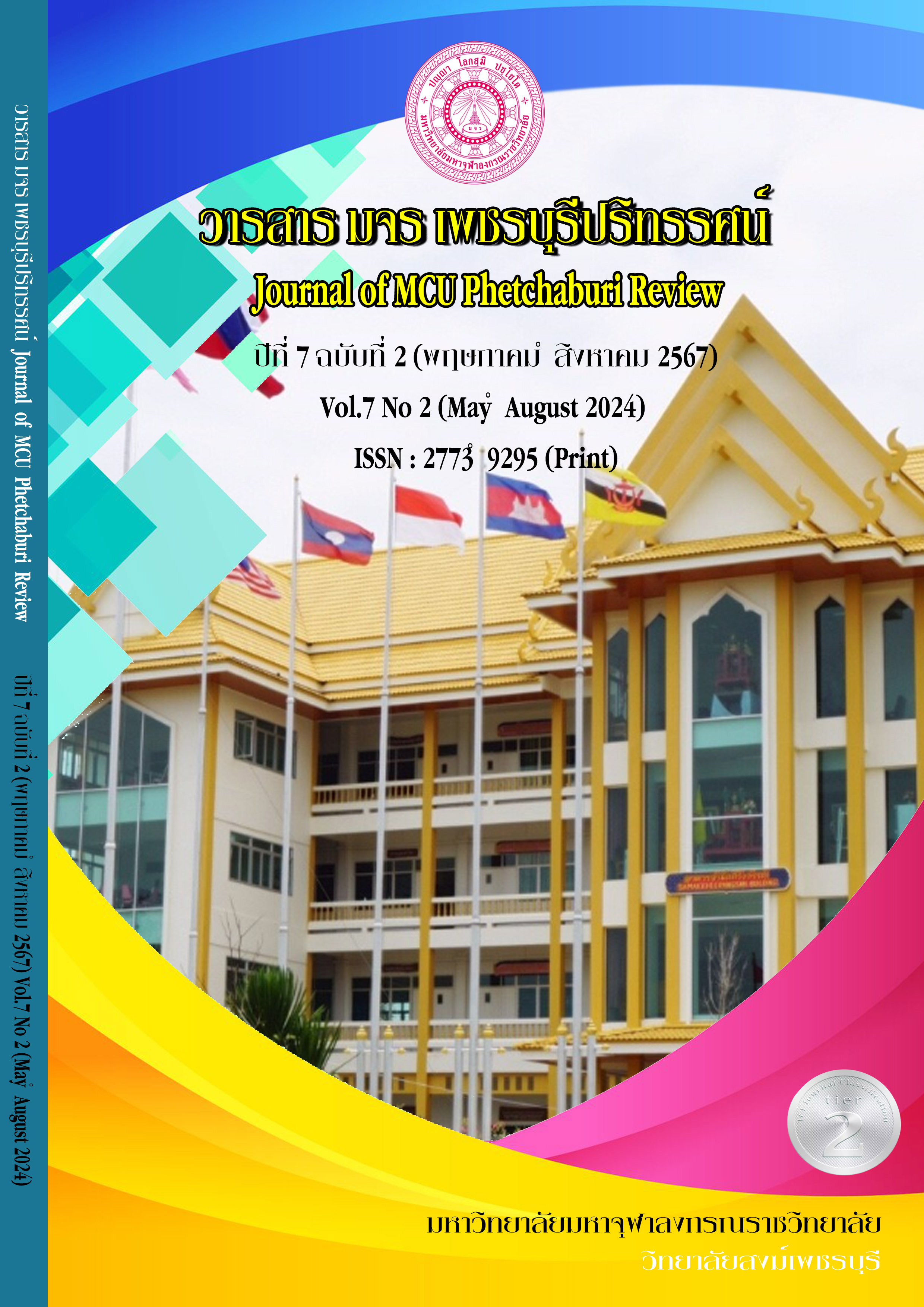PERCEIVED PRODUCT QUALITY OF FASHION CLOTHES VIA LIVE CHANNELS OF GENERATION Y CONSUMERS IN THE BANGKOK METROPOLITAN AREA.
Main Article Content
Abstract
The objectives of this research were 1) to study the demographic characteristics of the perception of quality of fashion clothes 2) to study the level of quality of fashion clothes 3) to study demographic characteristic that affect the perception of quality of fashion clothes via live channels. Use quantitative research models. The sample consisted of Generation Y consumers in the Bangkok Metropolitan Area who had experience purchasing products and services via live channels. 400 people using a specific random method. The statistics used are percentages, means, standard deviations, independent t-test, and Oneway ANOVA
The results of this research found that the respondents were mostly female, single, with a bachelor's degree, most of whom were employees of private companies with an average monthly income of 15,001-20,000 baht. There is a high level of awareness of the quality of fashion clothes, namely product performance, features, reliability, durability, and image and reputation. In addition, the difference of gender and status there is no effect on the perception of product quality in all 5 aspects. It affects the perception of product quality in terms of reliability differently. Professions are different It has different perceived quality of features. And different average monthly income It has different perceived product quality in terms of durability and image and reputation. However, by presenting products via live channels, sellers must create diversity. It should also have a good personality, attitude and sincerity towards consumers in order to create awareness of product quality and create more confidence in purchases.
Article Details

This work is licensed under a Creative Commons Attribution-NonCommercial-NoDerivatives 4.0 International License.
References
กนกวรรณ คชอาจ. (2564). แบบจำลองธุรกิจแคนวาสจำหน่ายเสื้อผ้าแฟชั่นสตรีผ่านการพาณิชย์อิเล็กทรอนิกส์ของกลุ่มเจเนอเรชันวายร้านลาน่าสโตร์. (รายงานการศึกษาอิสระปริญญาบริหารธุรกิจมหาบัณฑิต), มหาวิทยาลัยขอนแก่น, ขอนแก่น.
กรมการปกครอง, กระทรวงมหาดไทย. (2565). จำนวนประชากรจากการทะเบียน. from กรมการปกครอง สืบค้นเมื่อวันที่ 19 ธันวาคม 2565. เข้าถึงได้จาก: https://stat.bora.dopa.go.th/
กระทรวงพาณิชย์. (2564). ยอดการซื้อสินค้าออนไลน์. from กระทรวงพาณิชย์ สืบค้นจาก https://www.price.moc.go.th/price/fileuploader/file_admin_sum/news_survey-042564.pdf
ณัฐพล ใยไพโรจน์. (2562). Digital Marketing: Concept & Case Study. นนทบุรี: บริษัท ไอดีซี พรีเมียร์ จำกัด.
ปาจรีย์ ยังชู. (2564). พฤติกรรมการซื้อเสื้อผ้าแฟชั่นออนไลน์ของประชากรในจังหวัดกรุงเทพมหานคร. (บริหารธุรกิจมหาบัณฑิต), คณะบริหารธุรกิจ มหาวิทยาลัยรามคำแหง., กรุงเทพมหานคร.
รุ่งนภา บริพนธ์มงคล และกฤษดา เชียรวัฒนสุข. (2563). การรับรู้คุณภาพสินค้าและคุณภาพการบริการที่ส่งผลต่อการตัดสินใจซื้อซ้ำเครื่องทำความสะอาดอุตสาหกรรม. วารสารศิลปการจัดการ, 4(1), 166-179.
วัลภา สรรเสริญ. (2559). การตลาดออนไลน์: Online Marketing. กรุงเทพมหานคร: ศูนย์ส่งเสริมวิชาการ.
วิทวัส โชครัตนกาญจน์. (2560). แผนการตลาดในการจำหน่ายเสื้อผ้าแนวสตรีทของ FIL SHOP ผ่านสื่อสังคมออนไลน์. (รายงานการศึกษาอิสระปริญญาบริหารธุรกิจมหาบัณฑิต), มหาวิทยาลัยขอนแก่น, ขอนแก่น.
ศรัณยนันฑ์ ศรีจงใจ. (2561). ปัจจัยที่มีอิทธิพลต่อการตัดสินใจซื้อเสื้อผ้าแฟชั่นผ่านช่องทางการถ่ายทอดสดเฟซบุ๊กไลฟ์ (Facebook Live) ของผู้บริโภคในเขตกรุงเทพมหานคร. (สารนิพนธ์ บธ.ม. (การตลาด)), มหาวิทยาลัยศรีนครินทรวิโรฒ, กรุงเทพมหานคร.
ศุภวิชญ์ เหลืองจารุ และนิติพล ภูติโชติ. (2566). พฤติกรรมการซื้อเสื้อผ้าผ่านแพลตฟอร์มออนไลน์และปัจจัยส่วนประสมการตลาดในการเลือกซื้อเสื้อผ้าผ่านแพลตฟอร์มออนไลน์ของผู้บิโภคออนไลน์. วารสารการเรียนรู้สมัยใหม่, 8(2), 1-18.
สัณหณัฐ เจนเจษฎา. (2559). พฤติกรรมการบริโภคและช่องทางการตลาดสำหรับ Generation. สืบค้นเมื่อวันที่ 8 สิงหาคม 2564. เข้าถึงได้จาก: https://www.thaitradeusa.com/home/?p=21482.
สำนักงานพัฒนาธุรกรรมทางอิเล็กทรอนิกส์ (องค์การมหาชน). (2564). รายงานพฤติกรรมการซื้อสินค้าออนไลน์. สืบค้นเมื่อวันที่ 6 กันยายน 2564. เข้าถึงได้จาก: https://www.etda.or.th/th/
สุรพงษ์ คงสัตย์ และธีรชาติ ธรรมวงค์. (2551). การหาค่าความเที่ยงตรงของแบบสอบถาม. from มหาวิทยาลัยมหาจุฬาลงกรณราชวิทยาลัย สืบค้นเมื่อวันที่ 19 ธันวาคม 2565. เข้าถึงได้จาก: https://www.mcu.ac.th/article/detail/14329
อภันตรี อักษรประจักษ์ สมบูรณ์ ศรีอนุรักษ์วงศ์ และประภัสสร วิเศษประภา. (2560). การตัดสินใจซื้อเสื้อผ้าแฟชั่นผู้หญิงผ่านช่องทางการถ่ายทอดสดเฟซบุ๊กไลฟ์ของประชากรในกรุงเทพมหานคร. Retrieved from สืบค้นจาก http://www.mmm.ru.ac.th/mmm/is/twin6/sec1/6014154036.pdf
อรุโณทัย ปัญญา. (2562). ปัจจัยส่วนประสมทางการตลาดออนไลน์ที่มีผลต่อการตัดสินใจซื้อเสื้อผ้าแฟชั่นผ่านสังคมออนไลน์(เฟซบุ๊ก) ของนักศึกษาระดับปริญญาตรีในมหาวิทยาลัยเขตอำเภอเมืองจังหวัดเชียงใหม่. (การค้นคว้าอิสระบริหารธุรกิจมหาบัณฑิต), มหาวิทยาลยัราชภฏัเชียงใหม่., เชียงใหม่.
Cochran, W. G. . (1977). Sampling Techniques (3 ed.). New York: John Wiley & Sons.
Crosby, Lawrence A., Evans, Kenneth R., & Cowles, Deborah. (1990). Relationship Quality in Services Selling: An Interpersonal Influence Perspective. Journal of Marketing, 54(3), 68–81. doi:10.1177/002224299005400306
Kotler, P., & Armstrong, G. (2017). Principles of Marketing (17 ed.). United Kingdom: Pearson Education.


